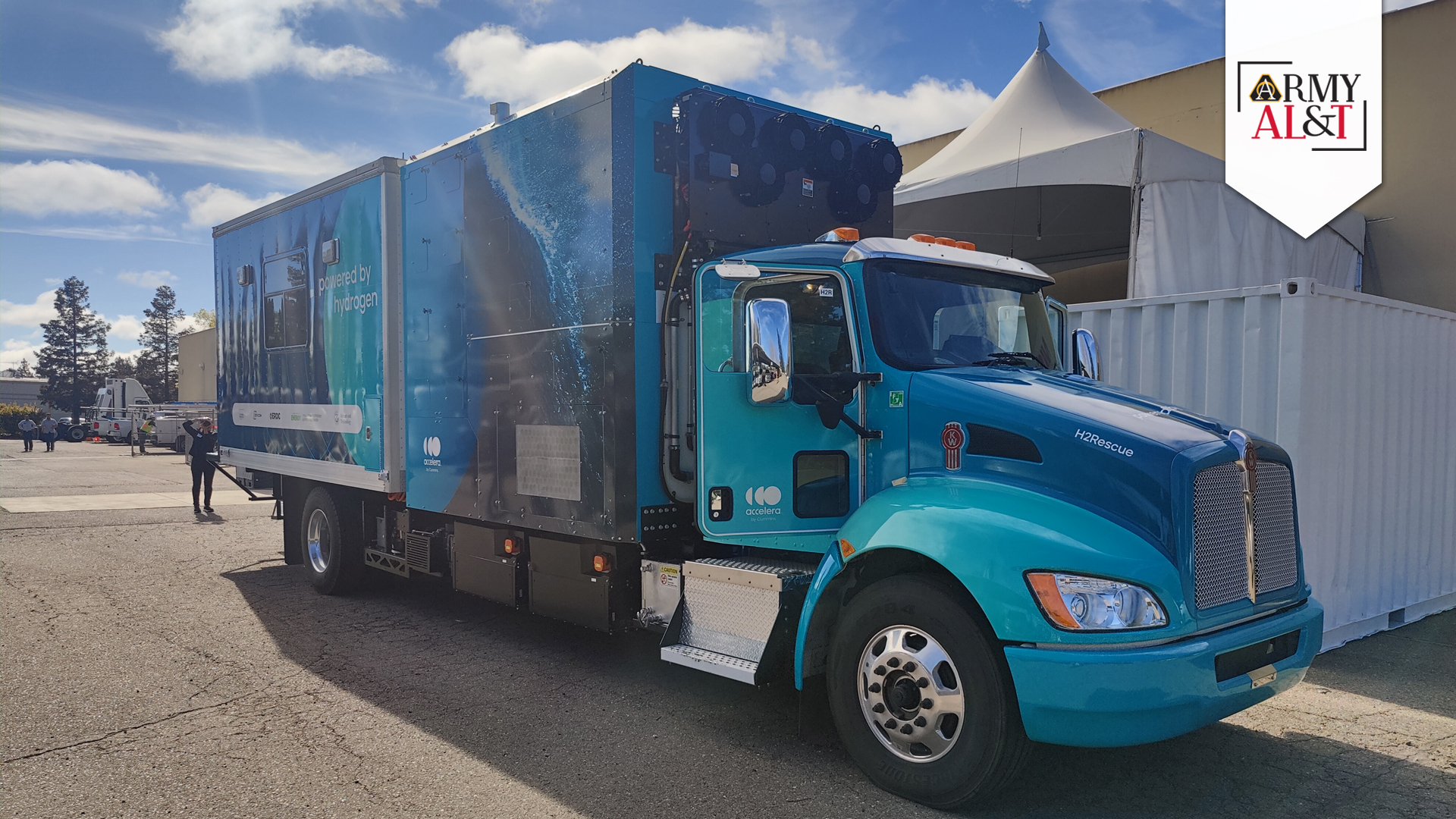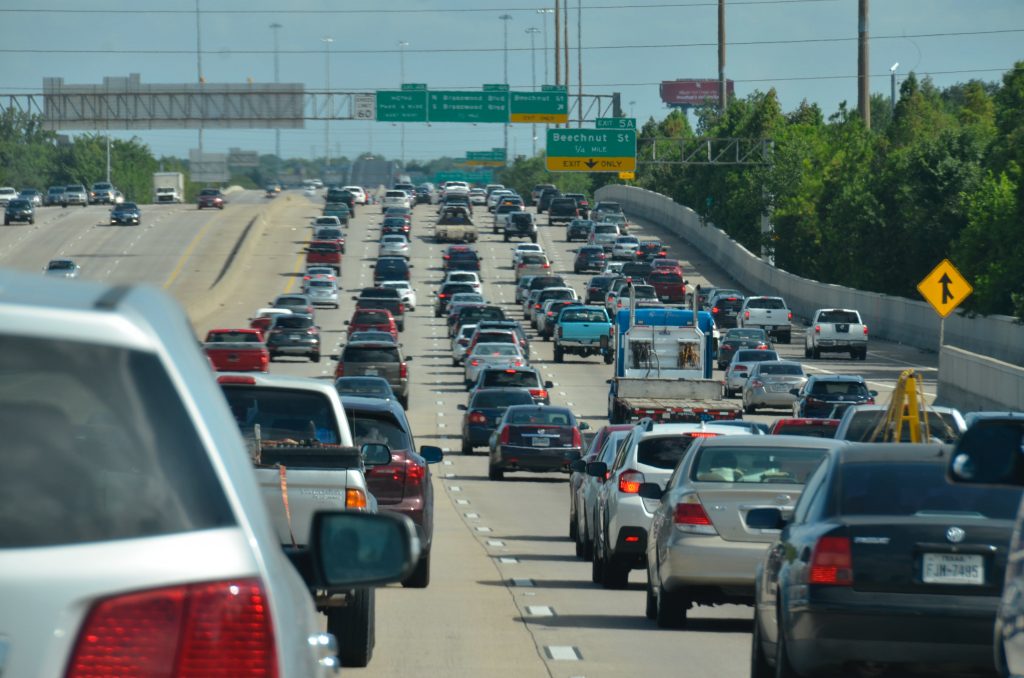
RESCUE POWER: The H2Rescue, a zero-emission, hydrogen fuel cell-powered emergency vehicle, can travel 180 miles to an area experiencing disaster. Once on site, the vehicle can provide heat, water and 25 kilowatts of power for up to 72 hours. (Photo by Kaley Skaggs, U.S. Army ERDC-CERL)
New hybrid H2 emergency vehicle brings the Army closer to reaching net-zero greenhouse gas emissions by 2050.
by Rebecca Wright
Significant shifts in weather patterns can eventually impact the Earth’s habitat and civilization. As climate change continues to pose a threat to our planet, DOD is recognizing actions that can be implemented to help mitigate its negative effects. One such action is the design and development of the H2Rescue—a zero-emission, hydrogen (H2) fuel cell-powered emergency vehicle that will provide disaster relief while also reducing greenhouse gas emissions.
The H2Rescue vehicle was developed in partnership with the U.S. Department of Energy (DOE) – Hydrogen and Fuel Cell Technologies Office; U.S. DOE – Vehicle Technologies Office; U.S. Army Combat Capabilities Development Command Ground Vehicle Systems Center (DEVCOM GVSC); U.S. Department of Homeland Security’s Science and Technology Directorate; Federal Emergency Management Agency; U.S. Naval Research Lab; and Accelera by Cummins (an energy technology company), with the U.S. Army Corps of Engineers’ Engineer Research and Development Center Construction Engineering Research Laboratory (ERDC-CERL) serving as the technical lead.
According to the United Nations, climate change refers to the increasing changes that are happening to our planet over a period of time. These changes include rising sea levels, acceleration of melting ice in the Arctic, changes in temperature and wind, extreme weather patterns and an increased likelihood of natural disasters. While some contributors to climate change are caused naturally (solar activity, volcanic eruptions), most changes are attributed to human activities, such as burning fossil fuels like oil, gas and coal. By burning fossil fuels, greenhouse gases are generated, which then trap the sun’s heat around the Earth causing global temperatures to rise. Carbon dioxide and methane are the primary greenhouse gases responsible for climate change. These gases are created by generating electricity, heating buildings and driving vehicles.
Transportation methods such as vehicles, ships and aircraft rank as some of the top leading sources of greenhouse gas emissions. Passenger vehicles, including cars and trucks, make up 41% of carbon dioxide emissions by burning petroleum-based fuel. Despite comprising only 4% of the U.S. passenger vehicles, trucks contribute to 23% of the greenhouse gases released into the atmosphere—and the U.S. Army is not exempt from contributing to these numbers.
The U.S. Army owns and operates a large fleet of various types of vehicles, including tanks, armored trucks and heavy equipment movers. According to a July 2021 Government Accountability Office report, the Army currently has over 242,000 vehicles in its fleet. As part of its 2022 Climate Strategy, the Army is aiming to reach net-zero greenhouse gas emissions by 2050. One of the strategies to reach this goal is by fielding all-electric vehicles—beginning with fielding hybrid tactical vehicles by 2035 and fully electric tactical vehicles by 2050.
AN ECO-FRIENDLY RESCUE
The consequences of climate change include extreme weather patterns and catastrophic storms, such as hurricanes, wildfires and dangerous flooding. The U.S. Army Corps of Engineers acts in response to these occurrences to deliver disaster relief.
Nicholas Josefik is an industrial engineer with ERDC-CERL and has been the technical lead on the H2Rescue project since October 2020. “We saw a need with all the natural disasters and emergency events happening and we wanted to improve the capabilities of some emergency resources,” said Josefik. In 2019, what began as a brainstorming session on how to improve emergency response capabilities, ERDC-CERL, DEVCOM GVSC and DOE’s Office of Energy Efficiency and Renewable Energy came up with the concept of H2Rescue. “When we came up with the idea, there [were] the California wildfires going out west, there were a couple of hurricanes in the southeast and we knew that big swaths of the U.S. were having these natural disasters [and] that customers didn’t have power, water and were just devastated,” Josefik said.
H2Rescue has the capability to travel approximately 1,500 miles on a single fuel-up when the hydrogen is used solely for driving, or it can travel a shorter distance and utilize some of the hydrogen to export power to a disaster-stricken location. For instance, when the H2Rescue covers a 180-mile round trip, the vehicle also has enough hydrogen fuel to provide 25 kilowatts of power for up to 72 hours. Once onsite, the vehicle can provide power, heat and water. The vehicle boasts a climate-controlled box bed that can serve as a mobile command center or a warming and cooling center. Additionally, the vehicle’s fuel cell can produce water that, once treated, can be used in an emergency. When describing a recent field demonstration of the vehicle, Josefik said, “It drove 180 miles and then we parked it. We started exporting power and exported at 25 kilowatts for 72 hours. That’s about enough to power 15 homes for three days straight.”

GETTING OUT OF A JAM: Carbon dioxide and methane are the primary greenhouse gases responsible for climate change. Passenger vehicles, including cars and trucks, make up 41% of carbon dioxide emissions. (Photo by Luigi Alvarez, Pexels)
THE HYDROGEN HUB
As a nonpolluting alternative to methane, hydrogen is the most abundant element on Earth and is estimated to make up 75% of the universe’s mass. As vehicles powered by gas and diesel expel harmful pollutants into the atmosphere, a major source of greenhouse gases, hydrogen offers a cleaner alternative. When hydrogen is used in a fuel cell, it produces only water and air. A fuel cell is an electrochemical device that generates electricity most often by using hydrogen and oxygen.
“A lot of people don’t know about fuel cells,” said Josefik. “A fuel cell is an electrochemical reaction, so it’s like a battery.” Fuel cells do not need recharging like standard batteries; if a fuel source, such as hydrogen, is provided the fuel cell will continue to produce electricity.
“There’s no combustion,” he added. And “they’re typically twice as efficient as combustion engines. So again, even if we use the same amount of fuel, we’ll probably get to go about twice as far,” Josefik said. “The fuel cell is used to drive the vehicle and we eliminated the need to bring combustion generators to the emergency; the vehicle is the generator. We have multiple electrical outlets all over the vehicle. So, you can just plug your equipment into H2Rescue.”
The H2Rescue vehicle, which can carry up to 176 kg of hydrogen within its 18-tank system, is expected to conserve approximately 1,825 gallons of fuel per year and is estimated to reduce greenhouse gas emissions by 2.5 metric tons per year.
Hydrogen is currently available in all 50 states from most compressed gas distributors. This availability will continue to expand with new funding provided through the Bipartisan Infrastructure Law, signed in November 2021. Included in the Bipartisan Infrastructure Law is the Regional Clean Hydrogen Hubs Program (H2Hubs), which includes $8 billion to form the foundation of a national hydrogen network. Under the authority of the DOE, the H2Hubs program will establish between six and 10 clean hydrogen hubs in the U.S. The hydrogen hubs will produce, store and distribute hydrogen in an effort to create a new form of readily available clean energy. This entails forming a network of producers and consumers along with creating connective infrastructure to distribute hydrogen that can be used to power vehicles, generate electricity and provide heat to homes and businesses.
AN H2 FUTURE
The H2Rescue vehicle has been demonstrated multiple times in 2023 and will have additional showcases across the U.S. in 2024. Although H2Rescue is still in the prototype phase, the team is already envisioning future enhancements. This includes upgrades to the current water production system with an aim to purify the water to levels suitable for human consumption. “The fuel cell produces water, so we can produce between 200 and 400 gallons of water on a single fuel up,” said Josefik. “Right now, you could use it for washing. …We are looking into a device to polish that water to bring it back to potable.”
While providing disaster relief is the current focus of the H2Rescue vehicle, the capability to provide future support to the Soldier is a potential outcome. “The reason we chose the emergency disaster area is because it’s a little easier to demonstrate that in our country. If we can prove it here, then we can harden it to be for that forward operating [area]. We have a long-term goal of being able to support that effort,” Josefik said. “We have nontactical vehicles in the military. …Right now, in the forward operating [areas], you bring in trucks, you trailer in combustion generators to produce energy, and then you bring in tankers worth of fuel. This is the same application. It could be applied in the forward operating base because instead of having to bring in those three different pieces of equipment, now you drive your vehicle to the location and your vehicle is your power generator.”
CONCLUSION
As the world continues to struggle with the threat of climate change, the military finds itself on a new battleground as the threat of global warming continues to rise. The military is adapting to a new environment where extreme weather patterns and more frequent natural disasters threaten future operations; and the continuance of emitting greenhouse gas emissions will only intensify the growing problem.
The H2Rescue vehicle aims to provide aid in disaster-stricken areas, but it will do so without consuming the same amount of energy as a standard vehicle, and without expelling greenhouse gases into the atmosphere. Hydrogen has potential to transform the energy pipeline with minimal impacts to the environment. When compared to traditional fuels, hydrogen holds versatility and the capability to transform energy consumption, making it a compelling choice for a cleaner and more sustainable future.
For more information, contact Nicholas Josefik at nicholas.m.josefik@usace.army.mil.
REBECCA WRIGHT is a writer and editor with Army AL&T and the U.S. Army Acquisition Support Center at Fort Belvoir, Virginia. She has over 14 years of experience writing and editing for the Department of Defense and the Department of Justice.







